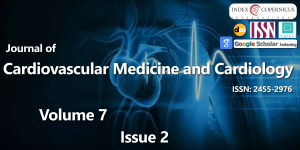The New Carotid Braided Stent CASPERTM RX. Single center experience in 50 cases
Main Article Content
Abstract
Purpose: Carotid stenosis, as well as dissections and pseudo dissecting aneurysms are etiological factors of Ischemic stroke. A new braided double-layer Nickel titanium Stent CASPERTMRX has super elasticity, shape-memory properties, combined with re-sheathable and repositionable, improving placement accuracy in a closed cell with flow diversion capability. To evaluate in clinical implant behavicor of in many different pathologies.
Materials and methods: It was implanted 53 CASPER-RX stents in 50 lesions (average age of 67 years; 29 men and 21 women) in different pathologies, high-grade symptomatic internal carotid artery stenosis in 43(86%) patients; and dissection in 7(4%) being: 4 dissecting pseudo aneurysms, 2 sub endothelial spontaneous dissections and 1 sub endothelial iatrogenic dissection. In all patients we used dual antiplatelet therapy, before treatment.
Results: Technical success achieved in all patients and complication rate (4%) and a 0% rate of neurological complications at 30 days. No stroke minor or restenosis after 6 months ultrasound or CT Scan examination FU.
Conclusion: CASPER™RX Stent conforms to tortuous anatomy, good wall apposition and a good conformation in tapered ICA-CCA segments in re sheathable delivery system. The very closed cells have a good result as a flow diverter. Technical success was achieved in all patients without clinical complications. However, we need long-term follow up to better assess the efficiency of this new device.
Downloads
Article Details
Copyright (c) 2020 Cabral de Andrade G, et al.

This work is licensed under a Creative Commons Attribution 4.0 International License.
Bosiers M, Deloose K, Verbist J, Peeters P (2005) Carotid artery stenting: which stent for which lesion? Vascular 13: 205-210. Link: https://bit.ly/2yR9SaR
Nikas DN, Kompara G, Reimers B (2011) Carotid stents: which is the best option? J Cardiovasc Surg (Torino) 52: 779-793. Link: https://bit.ly/35Tk9iO
Müller-Hülsbeck S, Schäfer PJ, Charalambous N, Schaffner SR, Heller M, et al. (2009) Comparison of carotid stents: an in-vitro experiment focusing on stent design. J Endovasc Ther 16: 168-177. Link: https://bit.ly/3buaY9A
North American Symptomatic Carotid Endarterectomy Trial (NASCET) Collaborators. Barnett HJM, Taylor DW, Haynes RB, Sackett DL, et al. (1991) Beneficial effect of carotid endarterec-tomy in symptomatic patients with high-grade carotid stenosis. N Engl J Med 325: 445-453.Link: https://bit.ly/2yPSSBG
Cremonesi A, Castriota F, Secco GG, Macdonald S, Roffi M (2015) Carotid artery stenting: an update. Eur Heart J. 36: 13-21. Link: https://bit.ly/3cES15q
Piorkowski M, Kläffling C, Botsios S, Zerweck C, Scheinert S, et al. (2015) Postinterventional microembolism signals detected by transcranial Doppler ultrasound after carotid artery stenting. Vasa 44: 49-57. Link: https://bit.ly/2SViHav
Touzé E, Gauvrit JY, Meder JF, Mas JL (2005) Prognosis of cervical artery dissection. Front Neurol Neurosci 20: 129-139. Link: https://bit.ly/2TgT8B1
Kennedy F, Lanfranconi S, Hicks C, Reid J, Gompertz P, et al. (2012) Antiplatelets vs anticoagulation for dissection: CADISS nonrandomized arm andmeta-analysis. Neurology 79: 686-689.Link: https://bit.ly/2WsxJ9W
Donas KP, Mayer D, Guber I, Baumgartner R, Genoni M, et al. (2008) Endovascular repair of extracranial carotid artery dissection: current status and level of evidence. J Vasc Interv Radiol 19: 1693-1698. Link: https://bit.ly/2zw1D3W
Biondi A, Katz JM, Vallabh J, Segal AZ, Gobin YP (2005) Progressive symptomatic carotid dissection treated with multiple stents. Stroke 36: e80-e82. Link: https://bit.ly/2Ah3wlk
Ohta H, Natarajan SK, Hauck EF, Khalessi AA, Siddiqui AH, et al. (2011) Endovascular stent therapy for extracranial and intracranial carotid artery dissection: single-center experience. J Neurosurg 115: 91-100. Link: https://bit.ly/3fJotFY
Pham MH, Rahme RJ, Arnaout O, Hurley MC, Bernstein RA, et al. (2011) Endovascular stenting of extracranial carotid and vertebral artery dissections: a systematic review of the literature. Neurosurgery. 68: 856-866. Link: https://bit.ly/2YXr1KA
Li Z, Chang G, Yao C, Guo L, Liu Y, et al. (2011) Endovascular stenting of extracranial carotid artery aneurysm: a systematic review. Eur J Vasc Endovasc Surg 42: 419-426. Link: https://bit.ly/2zBrG9L
Maras D, Lioupis C, Magoufis G, Tsamopoulos N, Moulakakis K, et al. (2006) Covered stent-graft treatment of traumatic internal carotid artery pseudoaneurysms: a review. Cardiovasc Intervent Radiol 29: 958-968. Link: https://bit.ly/3fJmoJY
Welleweerd JC, Jan de Borst G, de Groot D, van Herwaarden JA, Lo RT, et al. (2015) Bare metal stents for treatment of extracranial internal carotid artery aneurysms: long term results. J Endovasc Ther 22: 130-134. Link: https://bit.ly/3dDBEq0
Bosiers M, De Donato G, Deloose K, Verbist J, Peeters P, et al. (2007) Does free cell area influence the outcome in carotid artery stenting? Eur J Vasc Endovasc Surg 33: 135-141.Link: https://bit.ly/2T0FCBe
Hart JP, Peeters P, Verbist J, Deloose K, Bosiers M (2006) Do device characteristics impact outcome in carotid artery stenting? J Vasc Surg 44: 725-730. Link: https://bit.ly/3dMq641
Tadros RO, Spyris CT, Vouyouka AG, Chung C, Krishnan P, et al. (2012) Comparing the embolic potential of open and closed cell stents during carotid angioplasty and stenting. J Vasc Surg 56: 89-95. Link: https://bit.ly/2WQSGtV
Hopf-Jensen S, Marques L, Preiß M, Müller-Hülsbeck S (2015) Initial Clinical Experience With the Micromesh Roadsaver Carotid Artery Stent for the Treatment of Patients With Symptomatic Carotid Artery Disease. J Endovasc Ther 22: 220-225. Link: https://bit.ly/2T041GV
Timaran CH, Rosero EB, Higuera A, Ilarraza A, Modrall JG, et al. (2011) Randomized clinical trial of open-cell vs closed-cell stents for carotid stenting and effects of stent design on cerebral embolization. J Vasc Surg 54: 1310-1316. Link: https://bit.ly/3bnz9GJ
Wissgott C, Schmidt W, Brandt C, Behrens P, AndresenR (2015) Preliminary Clinical Results and Mechanical Behavior of a New Double-Layer Carotid Stent. J Endovasc Ther 22: 634-639. Link: https://bit.ly/2SZzjxS
Kabbasch C, Bangard C, Liebig T, Majd P, Mpotsaris A, et al. (2016) The Dual Layer Casper Micromesh Stent: Taking Advantage of Flow-Diverting Capabilities for the Treatment of Extracranial Aneurysms and Pseudoaneurysms. Cardiovasc Intervent Radiol 39: 472-476. Link: https://bit.ly/2T0xqRD





